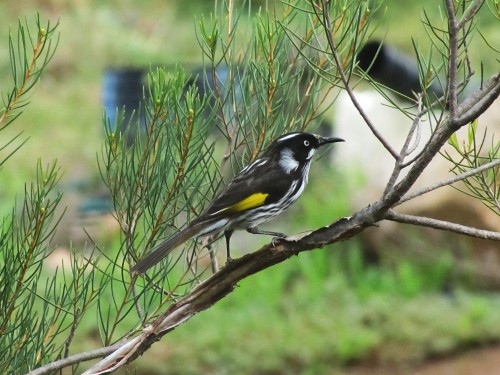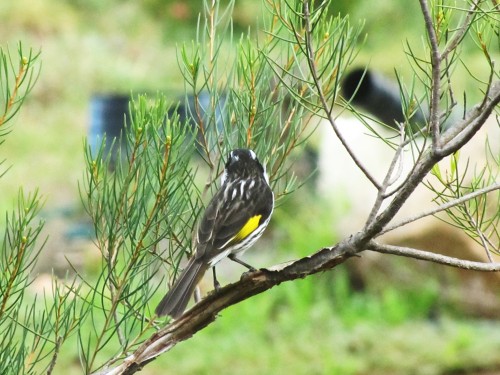Pigeons by the dozens (almost)
I had a doctor’s appointment this morning. Nothing major; just a check up.
As I was driving out of the driveway I noticed that one of the bushes in our garden had suddenly “sprouted” some extra colour. (Confession: the bush is actually dead – I just haven’t got around to removing it yet, or replacing it with something living.)
Eleven crested pigeons were sitting there all fluffed up against the chilly morning and enjoying the early morning sunshine. It wasn’t a very big bush, so it looked really great.
Crested Pigeons are very common in our area. I frequently see loose flocks of a dozen or more – sometimes as many as 30 or 40 – perched on power lines or fences. Once I even counted about 60 all in close proximity to one another. It was quite a sight.
New Holland Honeyeaters
Sometimes everything just works really well when taking photos of birds.
Here is a case in point.
I looked out of the window from my office and saw this New Holland Honeyeater perched on one of the branches of a bush in the garden. I grabbed my camera and clicked; I was quite pleased with the result.
Sometimes you do win them.
Grey Fantail at last
Sometimes it is the common species that give birders the most problems. With me it is getting good photos of the common garden bird, the Grey Fantail.
This bird has been visiting our garden in recent weeks. It is a regular visitor during the cooler months. I haven’t been able to get a good close up photo until earlier this week. I chased it around the garden on several occasions over the previous week, only to have it elude me and my camera every time. They are not known to sit still for very long.
Eventually, it settled on the bird bath for long enough for a photo. It then returned several times over the next few minutes; I was waiting with my camera ready focussed.
Common Starlings
The introduced bird species, Common Starling, is very common in our district, including our garden. They are also very common throughout south-eastern Australia, sometimes forming flocks numbering in the thousands.
They are a much maligned bird – and with good reason. We certainly don’t like the way they feast on the fruit in our orchard and they certainly foul up tree hollows when nesting, making the hollows most unattractive to native species.
They also have an uncanny knack of being able to imitate other birds. More than once I have been over excited about hearing an unusual call in the garden, only to realise that a starling is responsible. One of our resident starlings is able to very cleverly imitate a chook (chicken) cackling. Years ago we even had one around that was able to imitate the outside bell of a telephone, something it had learned from a nearby factory.
There is one redeeming feature of this species. At certain times of the year they do take on a very colourful, shimmering, iridescent array of colours, as shown in the birds featured in the photos today. (Hint: click on the photos to enlarge the image.)
Magnificent Wedge-tailed Eagles
Last week I travelled from home in Murray Bridge to attend a meeting in Adelaide. I take the South-eastern Freeway and this takes me through the Adelaide Hills. I generally take quite an interest in the birds seen along the way, noting that more and more frequently I am seeing the wonderful Yellow-tailed Black Cockatoos flying overhead.
On this occasion, however, I saw two – perhaps a pair – of Wedge-tailed Eagles soaring low over the freeway. This magnificent species – Australia’s largest eagle – is widespread throughout the country without being very common anywhere.
As is quite usual both birds were being harassed by other species, including Australian Magpies and Little Ravens. While they might be lovely birds, they are generally not loved birds; at least, not in the bird kingdom.









